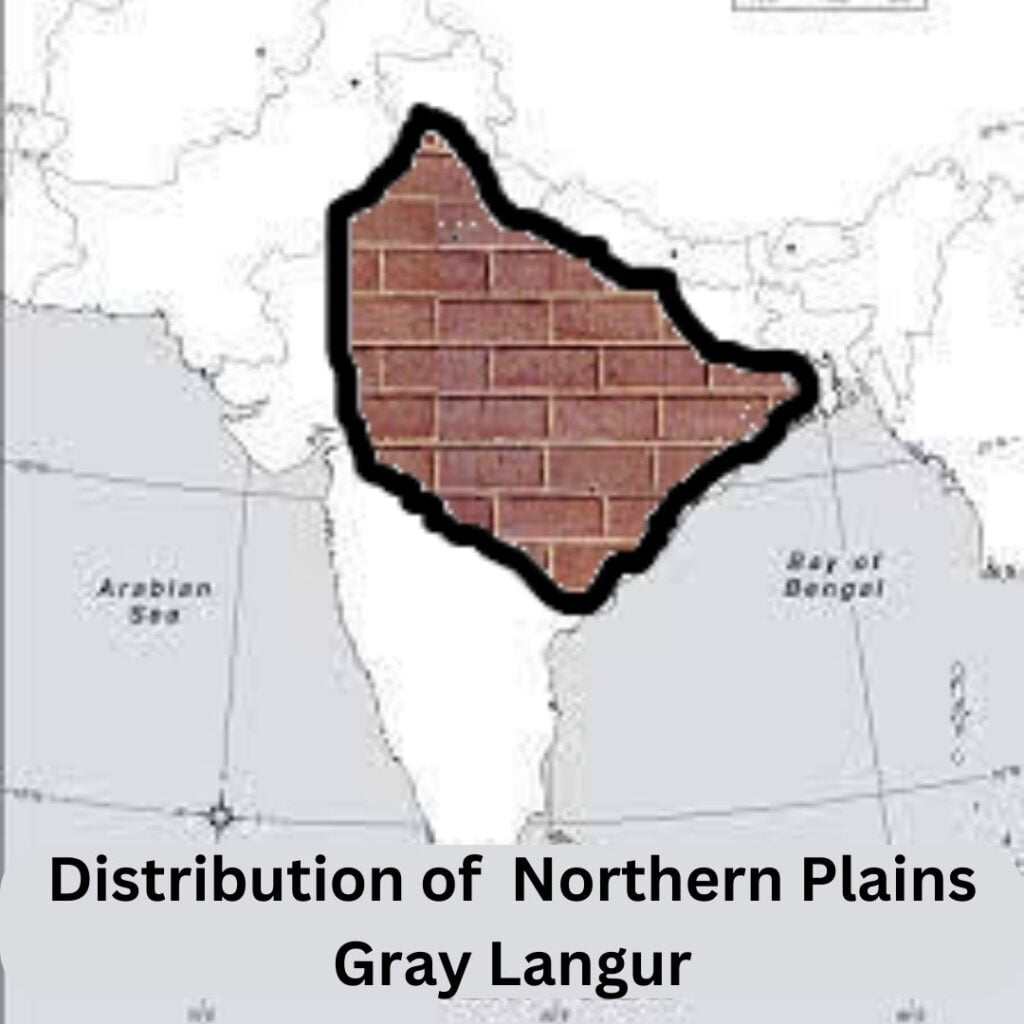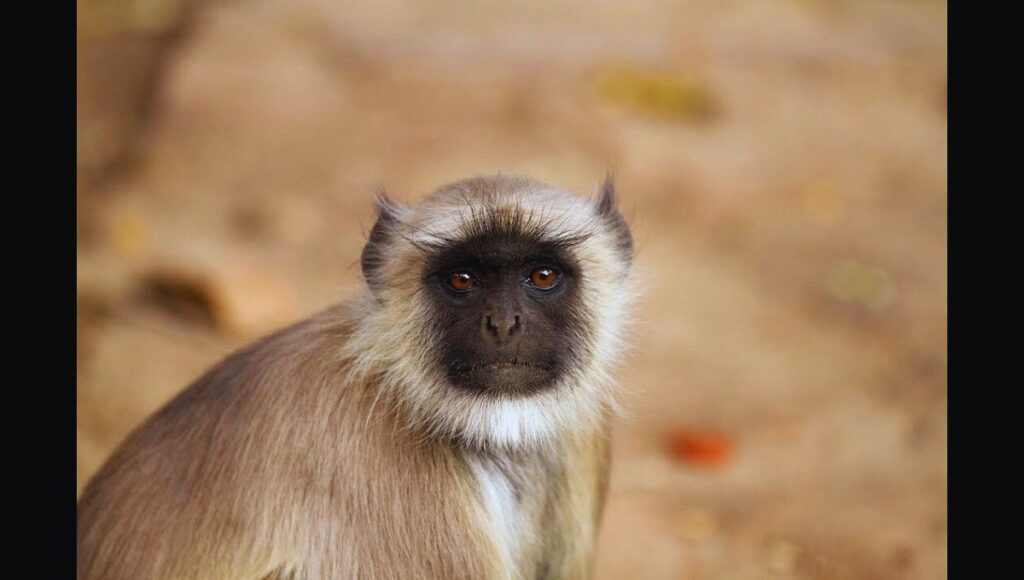Northern plains gray langur, also known as sacred langur, Bengal sacred langur and Hanuman langur, is a very enigmatic and fascinating creature that holds the attention of wildlife enthusiasts and nature lovers due to its character, behaviour, lifestyle and mysteries. In this article, we will delve into the world of northern plains gray langur and find out some interesting facts about the species.

Table of Contents
Northern Plains Gray Langur- In a Glimpse:
| Common Name: | Northern Plains Gray Langur |
| Scientific Name: | Semnopithecus entellus |
| Other Names: | Sacred langur, Bengal sacred langur and Hanuman langur. |
| Group Name: | Troop, Cartload or Tribe |
| Adult Length: | 45-80 cm |
| Adult Weight: | 9-20 kg |
| Tails Length: | 80-115 cm |
| Colour: | Light silver gray |
| Infants Colour: | Brown |
| Lifespan: | 30 years |
| Distribution: | India and Bangladesh |
| Habitat: | Dry and deciduous forests, shrublands. |
| Characteristics: | Diurnal, both terrestrial and arboreal. |
| Family Structure: | Lives in groups. |
| Diets: | Leaves, fruits, seeds, insects etc. |
| Gestation Period: | 200 days |
| Breeding Season: | December- May |
| Litter Size: | Usually 1 (sometimes 2). |
| Weaned at: | 1 Year |
| Sexual Maturity of Males: | 6-7 Year |
| Sexual Maturity of Females: | 4-5 Year |
| Predators: | Tigers, dholes, wolves etc. |
| IUCN Status: | Least Concern |
| CITES: | Appendix I |
6 Interesting Facts about Northern Plains Gray Langur:
Scientific Classification:
| Domain: | Eukaryota |
| Kingdom: | Animalia |
| Phylum: | Chordata |
| Class: | Mammalia |
| Order: | Primates |
| Suborder: | Haplorhini |
| Infraorder: | Simiiformes |
| Family: | Cercopithecidae |
| Genus: | Semnopithecus |
| Species: | Semnopithecus entellus |
Physical Descriptions:
The adults are covered by light silver-grey fur, but darker fur is also on the back and limbs. The face, hands, feet and ears are completely black. The infantas are usually brown in colour but with maturity, they turn gray. Their stomach is reddish-gold in colour. The wide mouth extending down at the side gives them a serious or sullen expression.

Size:
The length of the body (excluding tails) is 45-80 cm and the tails are longer than the body, usually between 80 cm and 115 cm, and are used for balance and locomotion. The adult males weigh 17-20 kg or 37-44 lbs and the females weigh between 9 kg (20 lbs) and 16 kg (35 lbs).
Lifespan:
The species can live up to 30 years. The females live more than the male. A male lives on average 18-24 years in the wild while a female lives more than 30 years of age.
Distribution and Habitat:

The northern plains gray langurs are found all over India extending from the south of the Himalayas to Krishna and Tapti rivers. It is also believed that the species is also introduced in Bangladesh on the banks of the Jalangi River by Hindu Pilgrims.
The langurs usually prefer dry and deciduous forests, shrublands and areas closer to human settlements with less disturbance. They are considered “Sacred” by Hindus and thus nicknamed “Hanuman Langur” after the name of Lord Hanuman.
Behaviour and Lifestyle:
The northern plains gray langurs are primarily diurnal in nature and are both terrestrial and arboreal. They spend half of their time on the ground and the other half on the trees or on any man-made tall structures (statues, buildings, poles etc). They prefer running instead of walking in a quadrupedal manner both on the ground and in the trees. The langurs can jump up to 15 feet horizontally and 40 feet descending, which makes them a hard target for predators.
Daily life and groups:
The langurs can form different types of groups including multiple males and females, one male and multiple females, one female and multiple males and a group of males without females. Sometimes an adult male lives alone without any group. Among all the groups, single male groups without females are the most common. Sometimes the size of groups exceeds 100 in number.

Males usually exit the natal group upon reaching maturity ( generally 5 years of age) but the females usually remain in the same group.
Adult females are more dominant over the older females of the group. Whenever a new male becomes the leader of the group it usually kills the infants of the previous male leaders, but this incident is less common when the takeover process occurs over a period of months. The females grooms the infants of both gender and the males don’t participate in it. The langurs also engage in grooming sessions with rhesus monkeys.
Communication:

A northern plains gray langur uses over 20 types of vocalization by adult males to communicate with the group members. This vocalization technique includes barks, grunts, alarm calls, loud whoops etc which can be heard over 2 km away. Different calls indicate different signals and situations.
They also communicate through gestures and facial expressions. The northern plains gray langur is often associated with Chital deer as both species respond to each other’s alarm call. The male langurs often alarm Chital deers about the potential threats and predators which can be seen from the top of the trees. In return, the deer helps the langurs using their ability to smell and hear from a long distance.
Diets:
The langurs are primarily herbivorous. They feed on fruits and leaves. They also eat seeds, flowers, buds, bark and insects, including caterpillars. As this species is considered sacred, many people and temples offer a lot of fruits, peanuts, bread, biscuits and vegetables to the langurs.
Reproduction and Family:

The reproduction process is directly linked to the availability of foods. If the groups have access to adequate food year-round, primarily from temples and the locality, then the females can breed throughout the year. Other groups, which don’t have availability of food all over the years generally reproduce between December and May.
The gestation period of the northern plains gray langur is about 200 days. The females give birth to one child, sometimes two. Females, other than the mother alloparent the infant for the first month of its life. The infantas weaned at 1 year and the male reaches maturity at 6-7 years.
Infanticide is common in many groups. Especially whenever a male takes over a group, he kills the infants of previous male leaders. Infanticide is also proved as a mating strategy for males as the mother of the infants quickly returns to estrus and allows the male to mate with her. The females mate with multiple males to confuse the males about the paternal identity of the infants and save the infants from infanticide.
Ecological Impact:
The northern plains gray langur plays an important role in seed dispersal. As fruits are an important component of their diet, they scatter the seeds once the seed has passed through their digestive system. Deer and cattle often consume the food which the langurs drop to the ground while foraging.
Threats:
The northern plains gray langur faces many threats, including anthropogenic threats over the years. These include,
- Habitat loss
- Road accident
- Attack by street dogs
- Forest fires
- Disease caught from domestic pets and livestock
- Hunting and Poaching
- Killed by farmers while raiding the crops, etc.
Predators:
Due to their excellent jumping abilities, the northern plains gray langurs don’t have many predators but sometimes tigers, dholes, wolves and golden jackals hunt them.
Conservation Status:
It is listed as Least Concern in the IUCN Red List of Threatened Species. It is also listed in Appendix I of CITES.
Conservation Efforts:
It is illegal in India to capture and kill the northern plains gray langurs.
Frequently Asked Questions (FAQs):
What are the predators of gray langur?
Tigers, Wolves, Golden Jackles and Dholes are the main predators of gray langurs.
Are langurs friendly?
Yes, langurs are friendly. They live in areas which are closer to human settlements. Many people offer food to langurs and langurs don’t harm humans easily unless they feel threatened.
Why are the macaques scared of langurs?
It is an age-old myth rhesus macaques are afraid of langurs. Somehow it is true. The rhesus macaques are smaller (53 cm in length) and lighter (5-8 kg) than northern plains gray langurs (45-80 cm long and weighing 9-20 kg). It is obvious that the langurs are stronger and while confrontation, they harm the macaques.
What is the lifespan of a langur?
Usually, langurs have a lifespan of 25-30 years.
What is the most friendly monkey to humans?
Bonobo apes are considered the most friendly monkey to humans. The species helps humans without even asking. Study reveals the DNA of the ape is 99% similar to humans
Also Read: Brown Hyena: 9 Interesting Facts About The Graceful Predator